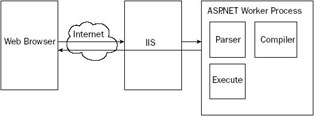ASP.NET Runtime
Using ASP.NET for Web applications on the client system just a simple Web browser is needed. You can use Internet Explorer, Opera, Netscape Navigator, Firefox, or any other Web browser that supports HTML. The client system doesn't require .NET to be installed.
On the server system, the ASP.NET runtime is needed. If you have Internet Information Services (IIS) on the system, the ASP.NET runtime is configured with the server when the .NET Framework is installed. If you have Windows XP Home Edition on your developer system, IIS is not available. With Visual Studio 2005, this is not a problem anymore because the Visual Web Developer Web Server is part of Visual Studio and can be used to test your Web applications.
Let's look at a typical Web request from a browser to show how the ASP.NET runtime goes into action (see Figure 18-1). The client requests a file, for example default.aspx, from the server. All ASP.NET Web pages usually have the file extension .aspx. Because this file extension is registered with IIS, or known by the Visual Web Developer Web server, the ASP.NET runtime and the ASP.NET worker process get into the picture. With the first request to the file default.aspx, the ASP.NET parser is started, and the compiler compiles the file together with a C# file that is associated with the .aspx file and creates an assembly. Then the assembly is compiled to native code by the JIT compiler of the .NET runtime. The assembly contains a Page class that is invoked to return HTML code to the client. Then the Page object is destroyed. However, the assembly is kept for the next requests, so with the second request it is not necessary to compile the assembly again.

Figure 18-1
EAN: N/A
Pages: 278
- Chapter IV How Consumers Think About Interactive Aspects of Web Advertising
- Chapter IX Extrinsic Plus Intrinsic Human Factors Influencing the Web Usage
- Chapter XI User Satisfaction with Web Portals: An Empirical Study
- Chapter XIII Shopping Agent Web Sites: A Comparative Shopping Environment
- Chapter XV Customer Trust in Online Commerce